Home - Interview
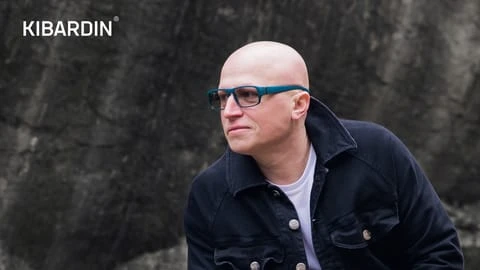
Interview with Vadim Kibardin, Founder and Head Designer of KIBARDIN Design
Home - Interview
by Mehmet Kaplan
The secret of good design is simplicity. The secret to being a good designer is to pay attention to every detail in the design process. From the moment the idea is born, the designer assumes many responsibilities such as choosing the right materials, creating a unique design idea, using technological innovations, and designing a product that can be produced without compromising functionality. Vadim Kibardin turned his first design idea into a tangible product in 1981 by using limited facilities, and this became the first concrete step in his successful career. Vadim designs products that solve the problems of people and make their lives more aesthetic. His inspiration is nature. With the understanding of designing innovative and functional products, he follows all current developments and presents rule-changing designs. As the evidence of the uniqueness of his design ideas, he is crowning his career with the awards he won with his designs. I talked with Vadim Kibardin, Founder and Head Designer of KIBARDIN Design, about his career and KIBARDIN Design.
Vadim, could you tell us about yourself? Who is Vadim Kibardin?
I am an inventor, author, scientist, and artisan. My designs bring about a positive social impact, materialize an ideology, and trigger specific human behavior. Most of my time, I spend looking for materials or technologies that define the future of humanity.
I want to make things of the only possible and apparent configuration that would be capable of meeting the expectations. Such items surprise you by their proper simplicity, as if you are already familiar with them, as though you have seen them somewhere before, but don’t remember where, it seems as if someone from the near future sent them to us, finding the best solution to correspond with our needs.
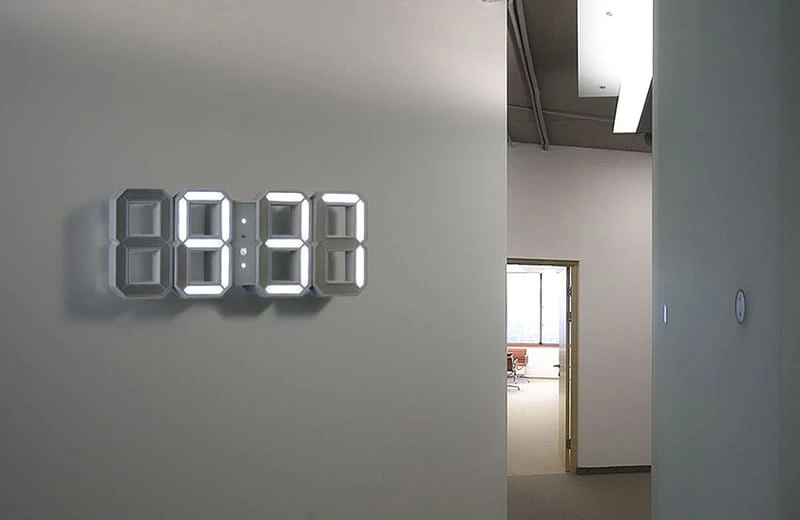
White & White - Designed by Vadim Kibardin
When did you first decide to become a designer? What or who inspired you?
I do not remember when I decide to become a designer. I was a really creative child and from an early age, I had to know how things worked and how people experience really good design. I used to dream about making anything really useful and truly beautiful. I remember when I was seven years old I really wanted to minimize everything to a particular size. I made a mini torch-light out of a lipstick case, an incandescent light-bulb, and watch batteries. It was in 1981! At this moment you can buy the same LED torch in all corners of the world. When I grew a bit older I enrolled for a course in drawing and composition in a special art-school and I graduated from Ural State Academy of Architecture and Art, Industrial Design Department, Ekaterinburg in 1996. Later I was the only designer to be given the German Chancellor’s grant in the area of industrial design.
I can’t tell that I was influenced by anybody too much. But there are a few designers who are my favorite among maestros, for example, Naoto Fukasawa, Ross Lovegrove, Konstantin Grcic. It is an incredible mix, but it seems I feel them and understand their way of thinking.
My main inspiration is nature. A close examination of nature can provide solutions to all sorts of aesthetic and engineering design problems, I strive to create products that ease man’s interaction with his environment. I work to do away with extraneous detail in the hope that my designs will express their beauty through their simplicity, their utility and their compatibility with the natural world.
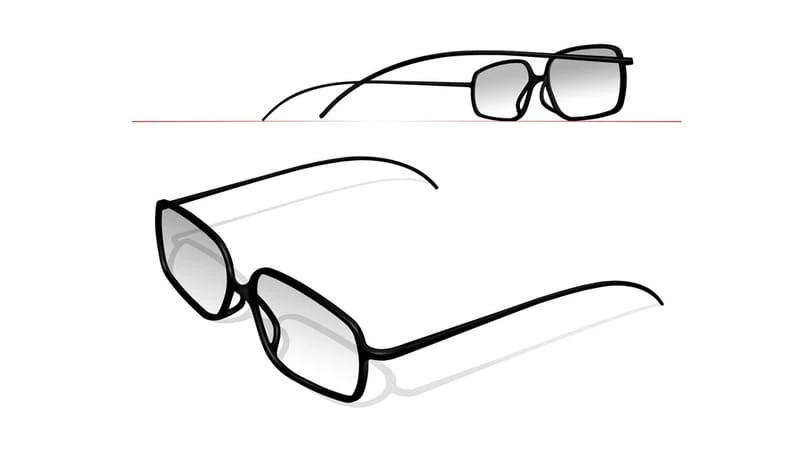
CerambixCerdo Glasses Frame - Designed by Vadim Kibardin
For example, my CerambixCerdo glasses frame got the Grand-Prix on Charmant International design competition organized by Charmant Company. According to the opinion of the president of the jury (Naoto Fukasawa), the CerambixCerdo glasses frame is the best solution of the contest’s challenge. The contest’s goal was to design glasses that would become the perfect and absolutely natural instrument. You will not even feel these glasses on your face while wearing because they fit perfectly.
A small beetle is comfortable with very long antennas. Strong, flexible and long, for insects they are necessary to survive. And at the same time, they have to be easy and comfortable to deal with. Just like my CerambixCerdo glasses frame.
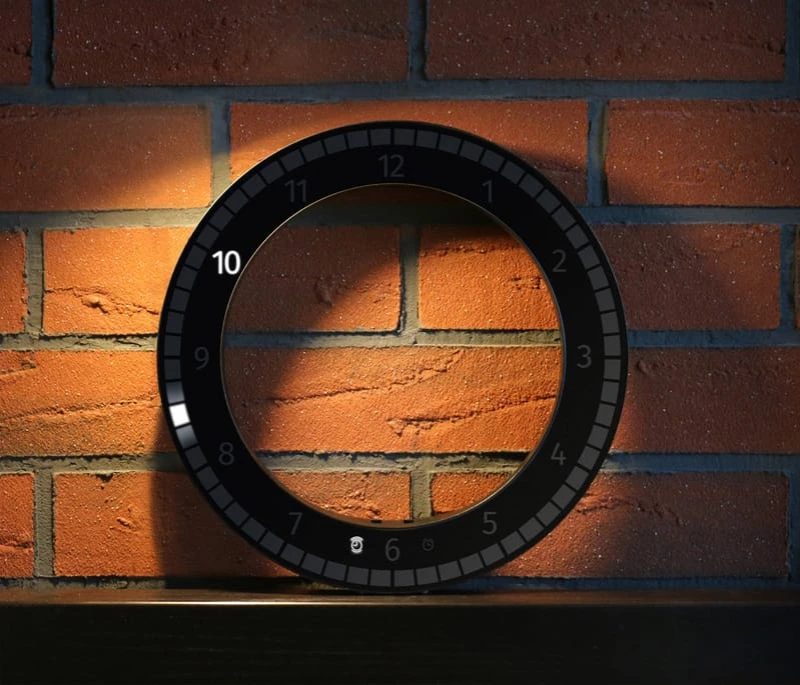
The Only Clock Black & Black - Designed by Vadim Kibardin
How would you describe your design approach? What is your signature in your designs?
My approach to design emphasizes both innovation and functionality. I take the minimalist philosophy of stripping an object to its essentials to a completely new level. When it comes to design, simplicity is often the best policy. According to Dieter Rams, good design is as little design as possible. In the process of making my products, I always focus on the essential aspects, not burdening my object with redundancy. Back to purity, back to simplicity is my slogan. I prefer simple shapes, and use materials that are best suited for this purpose. From a delicate, porcelain teacup, to an innovative LED wall clock.
The material world becomes more complex on the inside and streamlined on the outside. Objects lose their massive material body and turn into contours, imaginatively reminiscent of their purpose. Modern technologies allow placing electronics inside the product housing in such a way as needed to turn it into a logically and conceptually sound frame-like symbol. I’ve been using frame technologies in concept designs and my own products for more than 10 years. In 2000 I first published the “Q-time” wristwatch concept, which later was used as a prop in the A. Zeldovich movie “Mischen” (“The Target”). 2009 saw the introduction of the “Sputnik watch” concept. And the White and White Clock started off in 2009 as an ambitious-concept Black and White Clock using individual OLED components, and a production-ready model in a white case was released to the public in 2011. The White & White Clock has drawn a lot of attention from fellow designers and the general public.
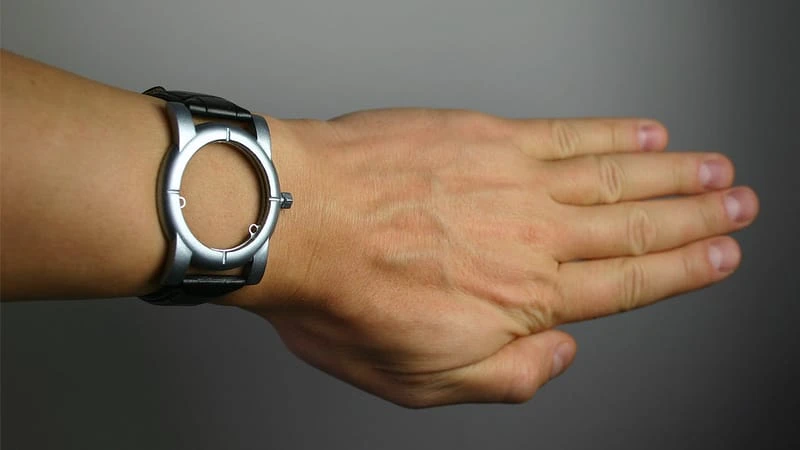
Q-time Wristwatch Concept - Designed by Vadim Kibardin
"Less is more" it is a slogan of minimalistic design, but when “less is more” becomes “how much is enough?” For me, the most challenging part of the design process is producing the best solution from different variants. Every project entails a few ways to solve a problem and different ways to define the look of a product. It’s quite hard and a large responsibility to decide which variant is really “enough” useful, marketable, and desired by the public.
My very popular The Only Clock is the next step in the evolution of time devices and is based on my research in the field of «framework technologies». A lot of people think that good design should evoke only emotions. But I think the object is a language everyone can understand with just a look. You don’t need instructions to understand it.
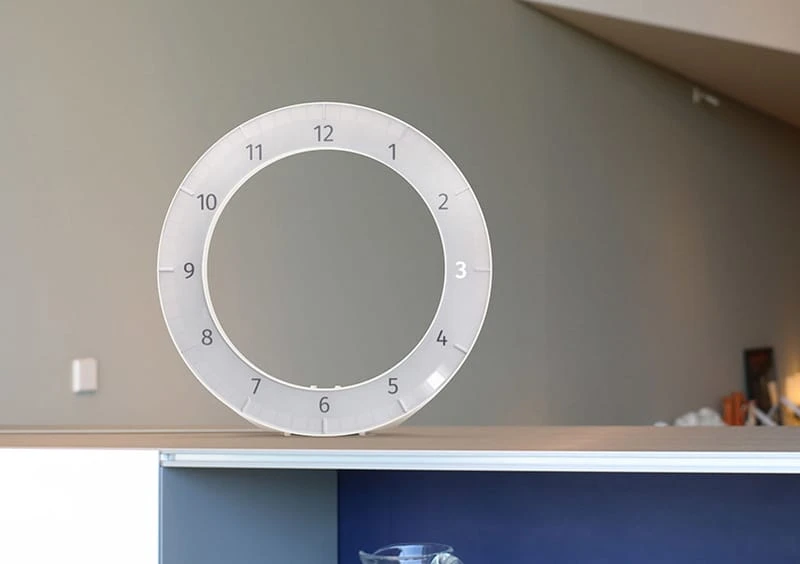
The Only Clock - Designed by Vadim Kibardin
I'm really trying to design iconic products and often using minimalistic design. By exploring new ideas, materials, and technologies, and executing them well, I hope my work is highly artistic, smart and always inspiring. You really trust them. You really wait for their creation.
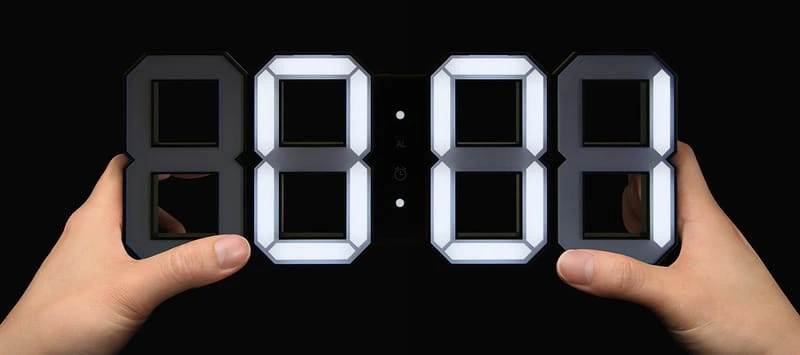
Black & Black - Designed by Vadim Kibardin
Could you tell us about KIBARDINDESIGN studio?
Since 2005 I have been living in Prague (Czech Republic), where I have established KIBARDINDESIGN studio and started production of my own trademarked goods which have been selling worldwide. The popularity of KIBARDIN products doesn’t depend on the region. Clocks and interiors of Kibardin production can be found in both museums and shelves of the world's best-known supermarkets. In the East, in Japan and Korea, where Vadim has fan clubs, in Europe, for example, in Paris's oldest supermarket Le Bon Marché, in the West, in Hudson's Bay or in the US at Barneys New York and right now you can buy my clocks in MoMA Design Shops.
Brand KIBARDIN, registered in 27 countries, is represented by the British company KIBARDIN ltd. on the international market. It is the official supplier of goods designed by Vadim Kibardin.
Generally, I create, produce and sell goods under my own trademark, but at the same time my studio works with clients. We focus on probing current trends to determine which technologies will define the highest quality of life, and help our clients deliver on its brand promises by designing beautiful forms with meaningful function. My studio work is targeted to deliver award-winning solutions that meet each client's marketing objectives.
Technologies, materials, manufacturing processes, trends, and markets are constantly evolving. By studying users and how they interact with the world around them, we bring insight to each project that enables us to design compelling product experiences. The first stage is the discovery phase. The goal of the discovery phase is to find new product opportunities and understand their technological features. Experience, brand and product come together to create goods that sell and enhance the brand message. Then become the Concept design phase.
The Concept is the initial phase of design, and the most important in ensuring optimal product development. Working closely with the client, we discuss product needs and conduct the necessary research to build the framework for the design. We start broadly, exploring copious ideas by generating various hand-drawn concepts. These conceptual drawings ultimately become the base for the rest of the development process. As new information is incorporated, we refine concepts further, and the elements of the experience of the physical object start to come together. Our process is iterative and inclusive, often involving many prototypes. At this early stage, a ‘quick-and-simple’ prototype that people are not afraid to criticize is best for testing principles.
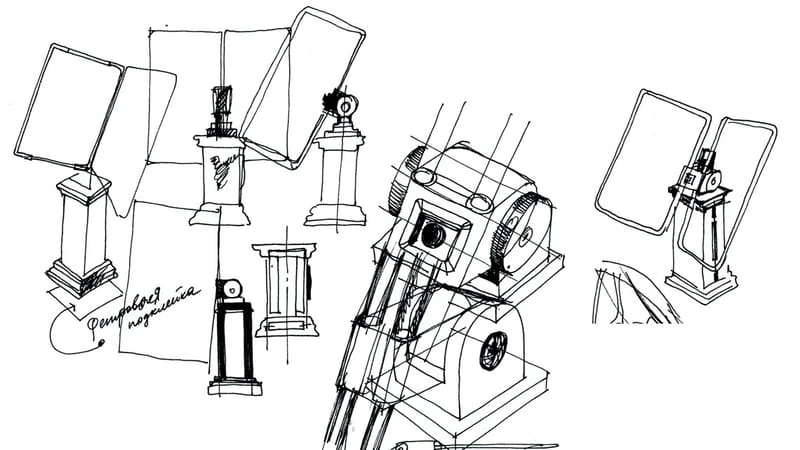
Computer & Frame Monitor - Designed by Vadim Kibardin
For me, the most challenging part of the design process is producing the best solution from different variants. Every project entails a few ways to solve a problem and different ways to define the look of a product. It’s quite hard and a large responsibility to decide which variant is really marketable, useful, and desired by the public.
To be sure in the success, we always go thru the third stage. It is 3D modeling. It allows to test, refine and manipulate virtual products prior to production. These designs are identical in dimension and detail to the desired finished product, ensuring quality and accuracy in production. Here we address all possible manufacturing concerns at the earliest design phases, and by understanding the manufacturing process we can reduce cost and development time, enabling optimum efficiency.
The final phase of the project is manufacturing sample based on real technology and using natural material. All my items are tested in the aggressive household environment. I drop, throw, drown, burn, gnaw, sharpen them, sit on them myself, and make others sit on them. This is the only way to understand what needs improvement and whether there is any point in improving at all. During this phase we identify, manage, and eliminate risks, fully defining even the smallest details. As a result, we have a product that is ready for manufacture at volume and on schedule.

The Only Clock - Black & Black - Designed by Vadim Kibardin
What type of projects do you prefer to work on? What is your favorite material to use in your designs?
It does not matter for me what I will work on. Right now I finalize developing the new arm-chairs and interior art objects, a few concepts with futuristic soul are also at the final stage. I have been involved in the creation and design of a range of different products, from consumer electronics to furniture and interior settings. My products are inspired by real life – they have ingenuity, flair, and thought all bundled up for our customers at unbeatable prices. Honesty. I use this philosophy to create an eye-catching and functional piece of art. It’s all about having a fancy solution for vital problems and inducing positive emotions.
Concerning materials, I think everything is good when suitable. For example, plastic chairs are suitable only for outdoors and no one can make me think otherwise and put them in my dining room. I will be glad to have wooden chairs. From the other side, it looks strange and anachronistically to use wood as a material for mass gadget market. Plastic is the best solution for such type of product with mass market requirements.

Paper Chair №1 - Designed by Vadim Kibardin
But I like to discover new ways of using materials. Look at my 100% paper furniture collection. It started from low paper armchair Black Paper 37- is a result of experiments with various materials and exploration of the co-existence of, ‘Chaos and Sequence’. The armchair is made of 37 paper layers and 20 details of gofer cardboard. The functional surface is formed by putting paper layers one by one to archive the required height on the chair. Simple paper not only possesses high constructional characteristics but can also dazzle through the beauty of its contours. A distinctive texture of the chairs’ overlay encourages a dialog with a user. A distinctly personalized form of the chair can be created by rumpling and chopping paper layers.
So, for the designer, it is required to only have the highest sense of proportion in order to select the correct material from the palette of modern opportunity and find a proper place for it.
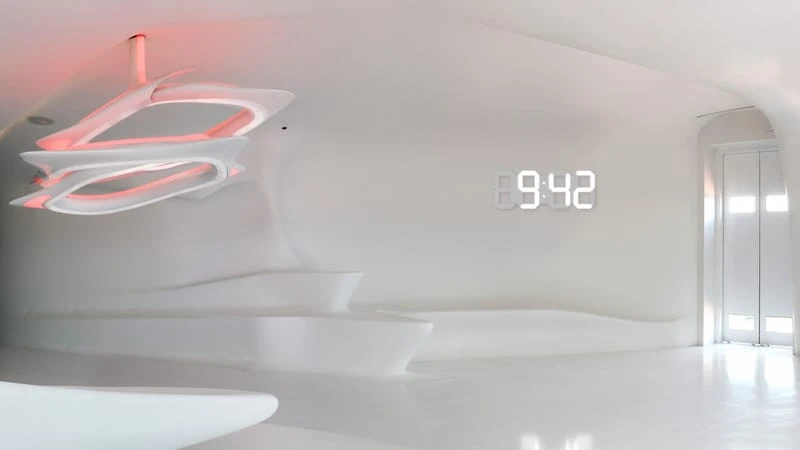
Mega White Clock - Designed by Vadim Kibardin
Could you tell us about your design clocks?
I am proud of my Clock & Watch Collection. On the website www.kibardindesign.com you can look at the unique and really good stuff.
My interest in timepieces design is not random or spontaneous. I always look for the new showing time solutions. About ten years ago I have designed the Black & White Clock concept with extremely innovative components. It is a digital clock: only figures, no case, only the essentials–just accurate time. The design of this clock based on my research in the field of “framework technologies." The Black & White clock design was publicized before the appearance of the White & White clock. The Black & White clock aroused huge interest from the public. I decided to postpone the batch production of the Black & White clock after detailed research of the production prototypes and to concentrate on the new model, White & White. During the working process, the ideal technical and constructive solutions for the White & White clock were found. These solutions comply with all the functional and aesthetic requirements for the clock and allow production for mainstream customers. We began selling worldwide with great success. Now we produce and sell about 10 different timepieces designs including limited watch editions.
I think the most inspiring product from my studio is legendary White and White Clock and my new the Only Clock become also popular. Both are more than a timepiece. It's a true expression of your personal taste, and also a professional tool. I, therefore, improve my clocks not only to reflect a wide range of styles and preferences. I also work on functionality and quality because I want you to love their reliability as much as you love their design.
And now we are so popular that counterfeiters have started using – or rather misusing – our popularity, and there are shallow people out there selling fakes using our name! We've done some stealthy research (after communications from some unhappy customers to whom counterfeits were sold) and discovered that copycat KIBARDIN products are indeed being manufactured and sold to vulnerable customers. Our products have thousands of hours of research and development behind them, and are engineered and re-engineered to perfection, to suit you and to be better than the rest! Our products are unique and have their own panache, which is why they can be copied but never recreated – the fakes will never have the spirit, research, thought and above all the quality in them!
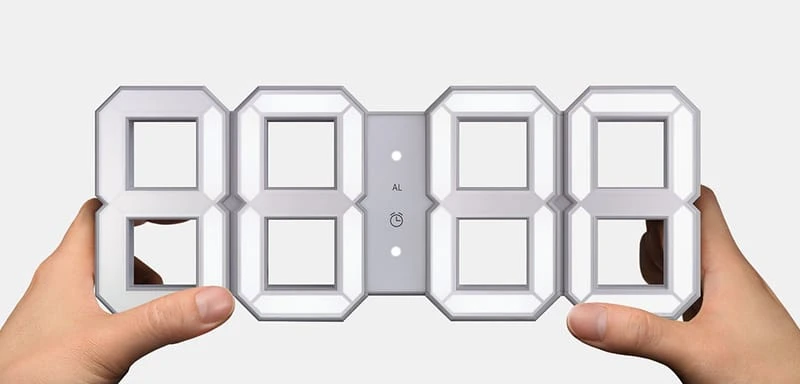
White & White LED Clock - Designed by Vadim Kibardin
How could you define White & White LED Clock with only three words?
My White & White LED Clock is clever clean and iconic.
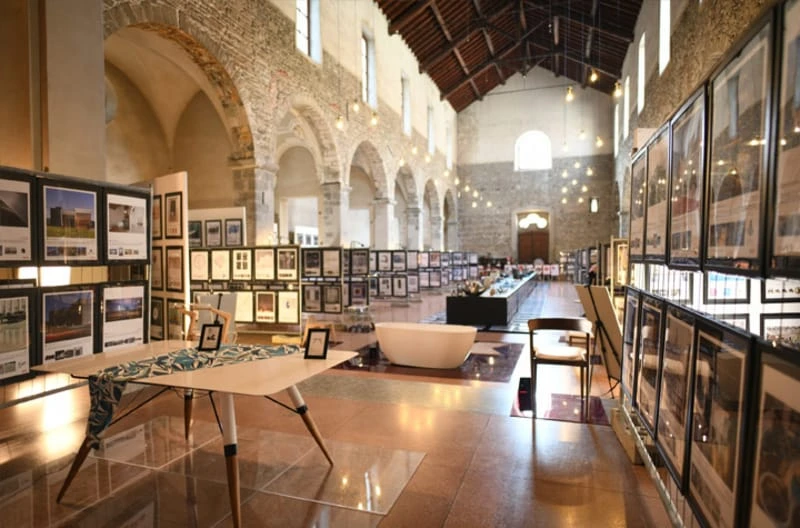
A' Winners' Exhibition at "MOOD" Ex Chiesa di San Francesco, Como, Italy
Could you tell us about your exhibitions? How does it feel to accept congratulations?
I have participated in more than 50 international exhibitions. It is a great pleasure for me and hard work at the same time. For example, one of the most important for me exhibition has been held in the Design Museum Holon. Thanks to Lidewij Edelkoort who selected my Black Paper Chair 37 for display during "Gathering" exhibition with 70 contemporary designers from around the world including Anton Alvarez, DrorBenshetrit, TordBoontje, Erwan& Ronan Bouroullec, Kiki van Eijk, Frederik Färg, Richard Hutton, Arik Levy, Bertjan Pot, Inga Sempé, Fredrikson Stallard, Patricia Urquiola and Tokujin Yoshioka. It was an honor for me to be part of such a powerful team, and I accepted the congratulations feeling of deep satisfaction. But it is just a step in my story. I have a dream someday famous museums like MoMA or V&Awill be showing my stuff during my personal exhibition.
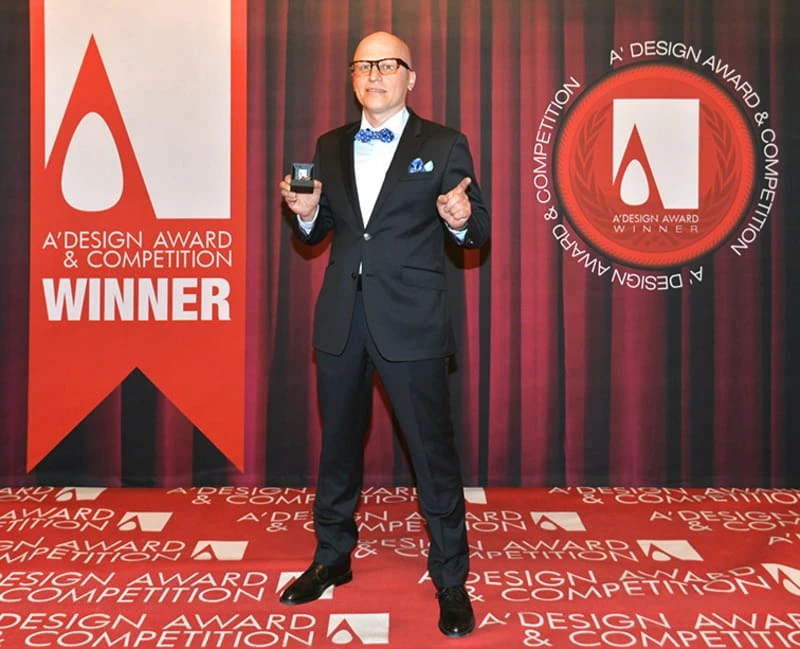
Vadim Kibardin at A' Winners' Exhibition
And you have won many notable awards. Could you tell us about the awards that you won?
Yes, the most striking examples of my projects have won the most prestigious international design awards such as “Good Design Award” “iF Product Design Award” and “Red Dot Design Award”, “A’Design Award and Competition”, “Promosedia International Design Competition”, “Design and Design”, “Charman design competition” and so on. Five years ago I was nominated in the Design section of the 2014 World Technology Awards. These award finalists and nominees are those individuals (in 20 categories) and companies/organizations (in 10 categories) who are—in the opinion of the WTN Fellows and Founding members, through the awards voting process—producing innovative work of “the greatest likely long-term significance” in their fields. We are those creating the 21st century. :)))
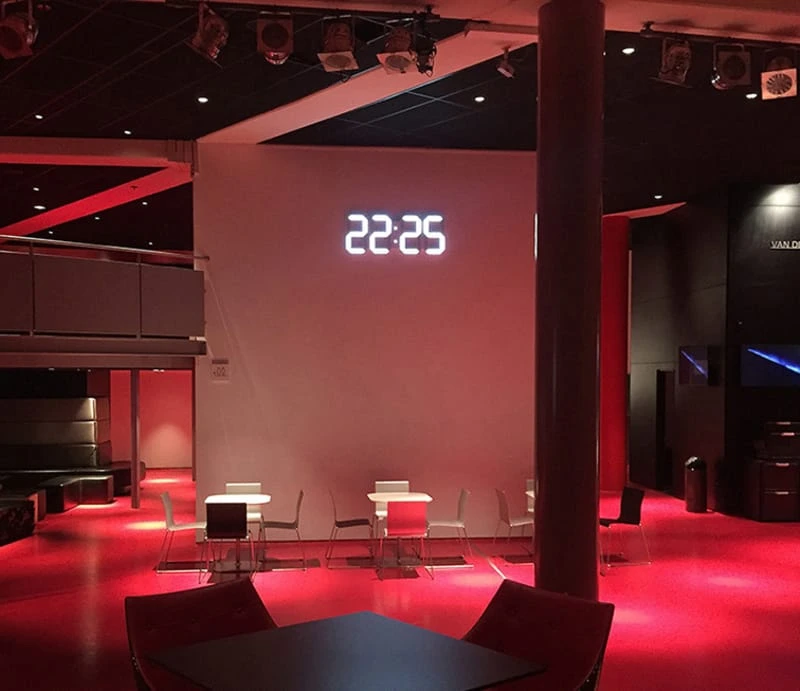
Chasse Theater - Designed by Vadim Kibardin
What do you think about 3D printers? How did they affect the design culture?
I have a good example. More than a year ago, the representatives of the Chasse Theater (the largest theater in the Netherlands) asked the studio to design an enlarged version of the well known White and White digital LED clock. It had to be a special design clock with 1,2 m length.
We created an absolutely unique design of the clock case. Each segment is a complete standalone module printed on a 3D printer as a whole, honeycomb structure inside each segment ensures the lightness and strength of the clock case. There is no other technology to produce such type of clock. This design allows replacing the module or its components quickly, without replacing other units. Only in this way, by controlling every step in the production process, it is possible to achieve the best quality. Our clock inside is as beautiful as outside. The total printing time is 256 hours.
The new Mega White clock has become a logical continuation of history. They kept all the important conceptual ideas of the previous models, but structurally and technologically, they began a new round in the KIBARDIN timepieces evolution.
Is it possible to produce the same one?
Yes
Is there any alternative technology which let us make such type of products?
No.
What was your first commercial work? What has been changed over the years from the first one to now?
About 15 years ago, I researched dissymmetry influence on the human reaction.
If the left and the right halves of the human face are close to absolute symmetry, it attracts attention and is called “Beauty”. However, the human mind distinguishes a small percentage of asymmetrical features and “Beauty” becomes natural. A face like that arouses “live interest” and does not excite any negative emotions. A reverse process takes place when we look at a mechanically constructed face that has absolutely symmetrical features. At first glance, it looks normal, but subconsciously the brain finds “dead” samples and sends a signal. One cannot distinguish any characteristic features in an absolutely symmetrical system: all parts are identical, equiprobable, and the system itself is simple, predictable and dull. We can see the same effect when comparing a photorealistic image, constructed by 3D programs, with a “live” object. Technologies allow the left and right halves of the body to be absolutely symmetrical but they cannot “make them alive”. In order to make that happen some smallest signs of not programmed chaotic asymmetry have to be brought in. These tiny discrepancies allow us to create a product with soul. Harmony is at the bottom of subconscious trust, both in a person, and a product, if it is a question, for example, of children's toys. Considering the symmetry and harmony phenomena, as basic methods of creation of form and image, on the examples of Barbie dolls and Teddy bears. An absolutely mirror symmetrical doll is an unattainable ideal of beauty and style of life. Perfect technologies make it possible to put the creation of perfect bodies on stream.
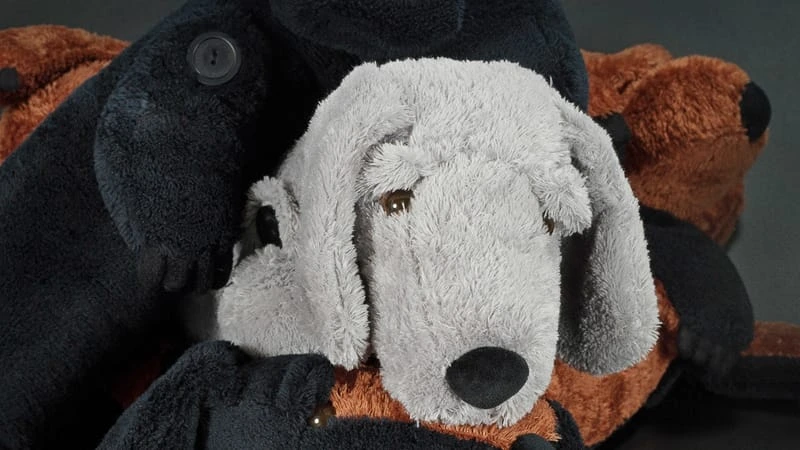
Garry Soft Toy - Designed by Vadim Kibardin
Teddy bears are a whole different story. Like a hundred years ago, children wish to fall asleep with a teddy bear. It’s both soft and kind, and "imperfect", it’s got a soul. I have created our soft toy called Garry dog, it is a soft toy with asymmetrical forms. It was the first really successful commercial work. Till now it is a very popular design, but nobody from our customers can explain why they are falling in love Garry.
For me, nothing changed from the first Garry to now. I hope every my design is one of the ways to make the world better thru human soul researching.
Generally, the task of industrial design is to create mass competitive products, which leads to a big variety of goods with practically equal characteristics. Market war is led on the style level. But most important is to create new product quality, a new picture of quality, new feeling. The search of such solution is conducted in different directions. New paints, polymer coating, fibers, new ways of surface finishing, new materials, contemporary technologies – all this for only one purpose – to give people new perceptions. I want to display something revolutionary with perfect balance in design and function using modern technology, but at the same time, I put something hidden from your eyes in the product.
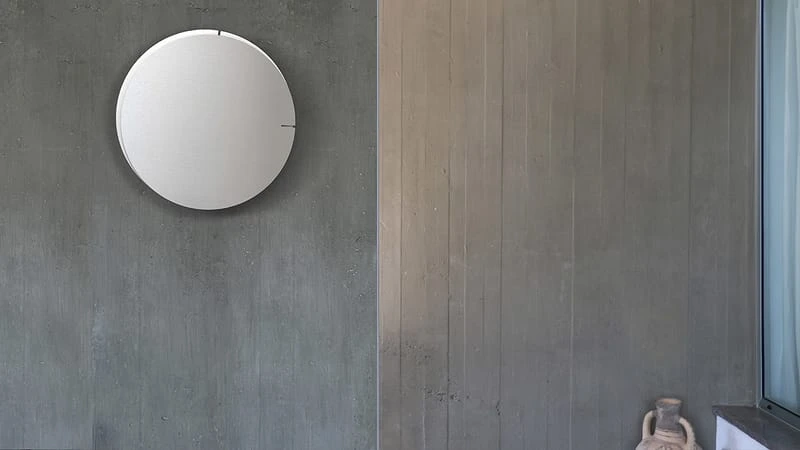
Melancholia Clock - Designed by Vadim Kibardin
What is the best advice you have ever received, and what advice would you give to young designers?
Wayne Gretzky, said: “I skate to where the puck is going to be, not where it has been.” The ability to anticipate the future is very important if you want to achieve your goal and be successful. I try to control the primary technology in everything we do and carefully calculate risks. If there is better technology available, I am willing to stop production of the old models and use the newest sci-fi researches to make new industry standards.
By not being afraid of failure or making mistakes, you can get yourself to take more risks.
Most of the time, I need to take risks in order to move forward. I think thoroughly, weigh the best and worse scenarios of an action against each other, and then decide whether the risk is worth taking. I have two main criteria before put in operation new product. I ask myself, does it have value and improve quality of life, would I use it in my personal environment.
I would advice work hard, to be flexible, and never stop study.
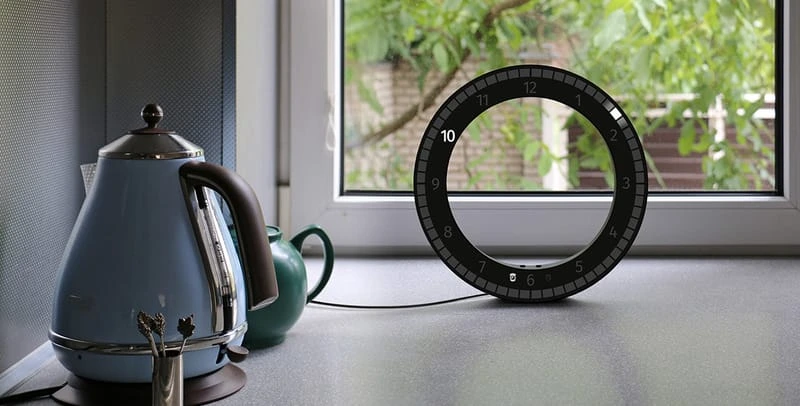
The Only Clock - Black & Black - Designed by Vadim Kibardin
Social media platform are new showcases for designer brands. What do you think about the power of social media on buyers' decisions?
It’s clear that design brands with e-commerce businesses need to have a strong social media presence in order to drive more sales. Social media platforms are very strong tools to show your individuality, but now it looks like information ocean and we can't swim without the help of consultants – influencers. Social influencers are typically pretty well-versed on social media and tag the store or brand of the products they use in their posts. This makes it easier for followers to become familiar with the brand and influence a purchase.
How can our readers follow KIBARDINDESIGN studio?
If you want to follow KIBARDINDESIGN studio you can subscribe to our newsletter at www.kibardindesign.com and stay updated on the latest special offers! Join 10,000 customers who already have subscribed and got free discount code for the selected product emailed to you weekly. Also, we use:
Instagram - https://www.instagram.com/kibardindesign/,
Facebook - https://www.facebook.com/Kibardindesign,
Youtube - https://www.youtube.com/channel/UCdv_9lInx3RSyjFMWk2-WTQ
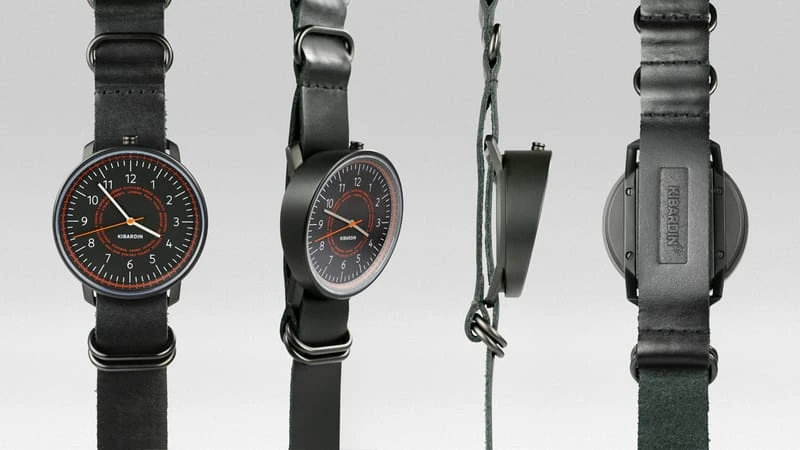
Just Watch JW-D2 - Designed by Vadim Kibardin
How can our readers buy KIBARDINDESIGN studio clocks?
It is very simple, just visit our e-shop using the follow link:https://www.kibardindesign.com/e-shop/ and buy something outstanding right now.
What is next for you?
When we talk about the future I think about invisible technology. The environment in which we live has gradually changed as homes and household appliances have evolved and information technology has developed. We are gradually moving toward a world in which form will disappear and the only function will remain. Things will continue to move in this direction. We don’t necessarily see a lot of objects in our space anymore. One gadget - simple iPhone has inside cameras, TV, music player, books and so on. Most of the real objects become services. It’s invisible. As well as time. For me, time is just a way of interpolating the past seamlessly into the present and present into the future.
We can see how designer’s role has changed in recent years from one of creating beautiful forms or focusing on the importance of social and ecological issues to one where the designer himself creates and visualizes new value, thinking about culture as a resource. It’s about the value that’s created around the product. And in this way, we understand that the lines between art and design are increasingly blurred. There is this growing number of collectors who want to collect design in the same way that they might collect art. Maybe in the future, we will see collectors who will collect interfaces design.
I think about it and work on new timepieces based on holographic and projection technology.
Anything you would like to add that I haven’t asked?
I like being at MoMA, but for me is more important to be in every home and make people life more comfortable and happy. I always work hard to meet my fans wishes, and use their feedback for new product designs. My challenge is to edit our lifestyle for the better. I hope my creations continue to spearhead innovative and exceptional design.
Thank you Vadim for your time.
For more information, please click here to visit the website of KIBARDIN Design
This interview was conducted in a Question-and-Answer format. The answers were checked for grammar and punctuation and published without any additional editing. Friday, March 15, 2019. All photos are the property of their respective owners.